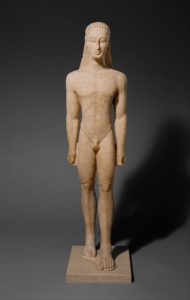Menkaure and Queen

Statue of Gudea

Kouros

Kroisos

Polykleitos, Doryphoros

Greek humanism is to desire explanation for events in the nature world and to open up new possibilities for speculation. It mainly valued humanity and placed human experience as the center of events. Greek and Roman art illustrates this in the way the human form is presented. One if the first evidence of it starting is in the Kouros figure made in 600 BCE. It is an idealized body of a man, but it is also very clearly a human. It stands on its own two feet giving it more of a up close and human quality compared to statues carved from walls, or with a block of stone supporting its back. Some of these statues are the Menkaure and Queen statue from 2450 BCE and the statue of Gudea from 2150 BCE.
The the Menkaure and Queen statue is clearly 2 people standing next to each other, but it was built to last for as long as it could. It was the depiction of a godly Pharaoh so it could be considered a monument too. You can see this looking at the large block of stone it’s connected to to add stability and longevity. The statue of Gudea is the same concept. It is the depiction of a ruler sitting and praying to his god. The chair is a block of stone making it a thick and solid piece of stone. It was meant to last. Both these statues are however lacking in human qualities compared to Greek and Roman art. Both of these statues exude a more otherworldly presence.
The Kouros figure is more human than the statues I mention above as it stands on it’s on 2 legs, but it was also built to last. It was very blocky, thick and large. The next statue down the line is Kroisos form 530 BCE. It was also blocky and large in a sense, but the shape and detail increases compared to Kouros. The arm are also more separate from the body. And one of the most strongest examples of humanity being the main focus is Polykleitos, Doryphoros form 450-440 BCE. It loses the stiffness and rigidity of the earlier statues. It has a very naturalistic pose. It is sculpted to imitate an actual human being. It’s skin looks soft and the face has emotion. This represents a shift from the the worship of Gods due to their power to a heightened responsibility for humanity to take care of their own problems.


Hi David, did you know what the midterm project is?